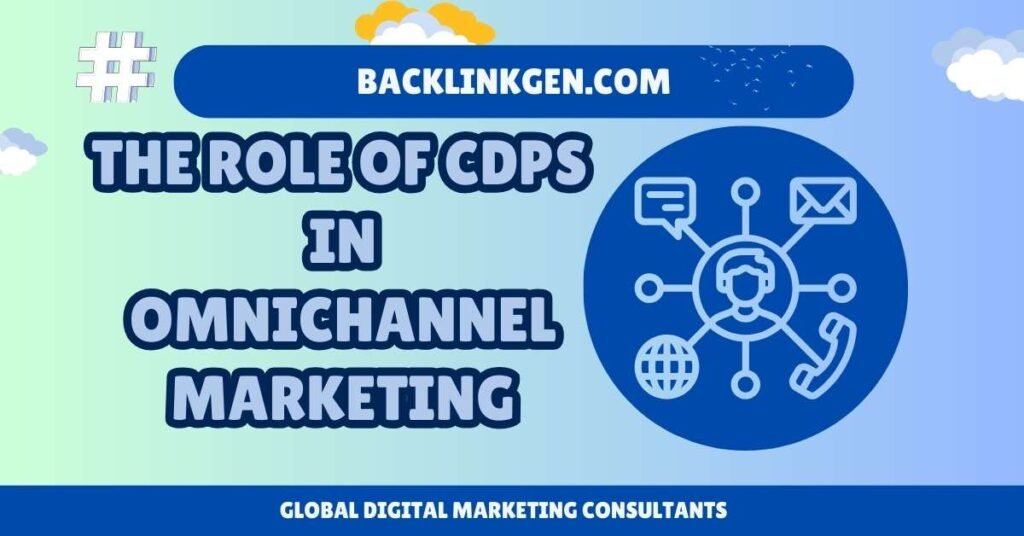As someone managing SEO and digital campaigns for a CRM SaaS company, 20 schools, and 5 colleges, I’ve seen firsthand how fragmented customer data can hold back marketing results. Many businesses use multiple platforms — CRM, email, social, ad platforms — but rarely tie them together effectively. That’s where Customer Data Platforms (CDPs) come in.
In this blog, I’ll walk you through what CDPs are, why they’re critical for omnichannel marketing, and how to use them to scale engagement and conversions.
1. What is a CDP?
A Customer Data Platform is a centralized system that collects, unifies, and organizes customer data from different sources (CRM, website analytics, ad platforms, social media, email tools). Unlike traditional CRMs or DMPs, CDPs focus on creating a single customer view (SCV) — a holistic profile of each customer that updates in real-time.
- CDP vs CRM: CRMs manage sales and relationships but lack deep behavioral tracking.
- CDP vs DMP: DMPs mainly handle anonymized ad data; CDPs track identifiable customers across channels.
2. Why CDPs Matter in Omnichannel Marketing
Omnichannel marketing means reaching customers seamlessly across web, social, email, ads, and offline touchpoints. Without integration, campaigns feel disjointed. A CDP helps by:
- Unifying customer data for accurate personalization.
- Eliminating data silos between platforms.
- Tracking user journeys across multiple touchpoints.
- Enabling real-time personalization based on behaviors.
Example: A student who clicks on a college email about scholarships can later be retargeted with relevant Facebook ads because the CDP connects their actions across platforms.
3. Benefits of CDPs in Omnichannel Marketing
a) Personalization at Scale
CDPs let you move beyond generic campaigns. By understanding preferences and behaviors, you can send personalized messages across email, push notifications, and ads.
b) Smarter Segmentation
With unified profiles, you can segment by behavior (abandoned cart, video watched, class registered) instead of only demographics.
c) Improved ROI
Marketing spend is more efficient when messages target the right people, at the right time, on the right channel.
d) Better Customer Experience
Customers experience a consistent journey across channels rather than disconnected brand interactions.
4. Real-World Applications of CDPs
- CRM SaaS: Segment prospects who downloaded a whitepaper vs. those who requested a demo.
- Schools: Target parents who visited admission pages but didn’t fill out forms.
- Colleges: Send personalized campaigns about courses based on interests tracked via the website and social.
5. Challenges Without CDPs
If you’re not using a CDP, you’re likely dealing with:
- Duplicate customer records.
- Inefficient ad spend due to poor targeting.
- Lack of attribution clarity.
- Frustrated customers receiving repetitive or irrelevant messages.
6. Key Features to Look for in a CDP
- Data Integration – Ability to connect with CRMs, analytics, ad platforms, and email tools.
- Real-Time Updates – Customer profiles that adapt as soon as actions are taken.
- Identity Resolution – Matching different IDs (email, cookies, device) into one customer view.
- Advanced Segmentation – Granular filtering based on actions and attributes.
- AI-Powered Predictions – Forecasting churn, likelihood to buy, or engagement patterns.
- Cross-Channel Activation – Ability to push segments into email, social, and ads instantly.
7. How to Implement a CDP in Your Omnichannel Strategy
- Step 1: Define Goals – Whether it’s increasing sales, boosting enrollments, or improving retention.
- Step 2: Map Data Sources – Identify every platform where customer data lives.
- Step 3: Choose the Right CDP – Tools like Segment, BlueConic, or Tealium are popular.
- Step 4: Integrate Channels – Connect your CRM, email, ads, and analytics into the CDP.
- Step 5: Build Unified Profiles – Create SCVs for every customer.
- Step 6: Launch Personalization Campaigns – Send targeted, relevant messages.
- Step 7: Measure & Refine – Track performance and optimize.
8. CDPs and Data Privacy
One critical aspect is GDPR and CCPA compliance. Since CDPs centralize customer data, they must be secure and give customers control over their information. Always ensure your CDP is privacy-compliant and transparent.
9. Future of CDPs in Omnichannel Marketing
As AI advances, CDPs will become even more powerful by predicting intent and automating campaigns. We’ll see:
- AI-driven personalization in real time.
- Deeper integrations with ad platforms for automated budget allocation.
- Voice, IoT, and AR/VR data becoming part of the omnichannel mix.
10. My Take as a Digital Marketing Consultant
Having managed campaigns across schools, colleges, and SaaS businesses, I can confidently say CDPs are not just “nice-to-have” tools anymore — they are essential infrastructure for global marketing success. They bridge the gap between marketing vision and execution by giving you a true picture of the customer journey.
Omnichannel marketing without a CDP is like running a marathon with one shoe — possible, but unnecessarily painful.
Conclusion
A CDP transforms scattered customer data into actionable insights, enabling marketers to create seamless, personalized, and measurable omnichannel campaigns. Whether you’re managing education, SaaS, or e-commerce, investing in a CDP is a long-term win for customer experience and ROI.

